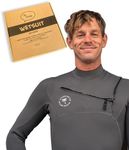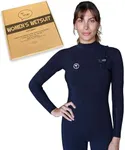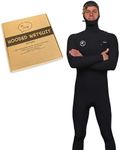We Use CookiesWe use cookies to enhance the security, performance,
functionality and for analytical and promotional activities. By continuing to browse this site you
are agreeing to our privacy policy
Best Semi Dry Wetsuits
From leading brands and best sellers available on the web.How do we rank products for you?
Our technology thoroughly searches through the online shopping world, reviewing hundreds of sites. We then process and analyze this information, updating in real-time to bring you the latest top-rated products. This way, you always get the best and most current options available.

Most Popular Categories Right Now
Buying Guide for the Best Semi Dry Wetsuits
Choosing the right semi-dry wetsuit is crucial for ensuring comfort, warmth, and flexibility during your water activities. Semi-dry wetsuits are designed to keep you warmer than standard wetsuits by minimizing the amount of water that enters the suit. They are ideal for colder water conditions and can be used for various water sports such as diving, surfing, and snorkeling. To make an informed decision, you need to consider several key specifications that will determine how well the wetsuit meets your needs.ThicknessThe thickness of a semi-dry wetsuit is measured in millimeters and indicates how much insulation it provides. Thicker wetsuits (5mm to 7mm) offer more warmth and are suitable for colder water temperatures, typically below 15°C (59°F). Thinner wetsuits (3mm to 5mm) are more flexible and better suited for slightly warmer waters, around 15°C to 20°C (59°F to 68°F). Choose the thickness based on the water temperature you will be encountering most often. If you tend to feel cold easily, opt for a thicker suit.
SeamsThe seams of a semi-dry wetsuit play a significant role in its ability to keep water out. There are different types of seams, such as flatlock, glued and blind-stitched, and taped seams. Flatlock seams are durable but allow some water to seep in, making them suitable for warmer conditions. Glued and blind-stitched seams are more watertight and better for colder waters. Taped seams provide the highest level of water resistance and are ideal for very cold conditions. Consider the water temperature and your tolerance to cold when choosing the seam type.
Zipper TypeThe type of zipper on a semi-dry wetsuit affects both its ease of use and water resistance. Back zippers are the most common and easiest to put on and take off, but they can allow more water to enter. Chest zippers offer better water resistance and flexibility but can be more challenging to don. Some wetsuits feature no zippers, relying on stretchy materials for entry, which provides the best water seal but can be difficult to put on. Choose a zipper type based on your preference for ease of use versus water resistance.
FitA proper fit is essential for a semi-dry wetsuit to function effectively. The suit should be snug but not too tight, allowing for a full range of motion without restricting blood flow. A well-fitting wetsuit minimizes water entry and maximizes insulation. When trying on a wetsuit, ensure there are no gaps at the neck, wrists, and ankles, as these can let in water. Consider your body shape and size, and try on different brands and models to find the best fit for you.
MaterialSemi-dry wetsuits are typically made from neoprene, a synthetic rubber that provides insulation and flexibility. The quality of neoprene can vary, with higher-end wetsuits using more flexible and durable materials. Some wetsuits also feature additional linings or coatings to enhance warmth and comfort. When choosing a wetsuit, consider the quality of the neoprene and any additional features that may improve your experience. Higher quality materials will generally offer better performance and longevity.
Additional FeaturesSome semi-dry wetsuits come with additional features such as reinforced knee pads, integrated hoods, or wrist and ankle seals. These features can enhance the durability, warmth, and overall performance of the wetsuit. Reinforced knee pads are useful for activities that involve a lot of kneeling, while integrated hoods provide extra warmth for the head and neck. Wrist and ankle seals help to further reduce water entry. Consider which additional features are important for your specific activities and conditions.










